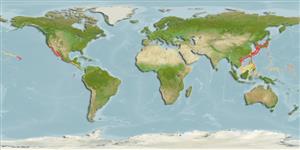Teleostei (teleosts) >
Holocentriformes (Squirrelfishes, soldierfishes) >
Holocentridae (Squirrelfishes, soldierfishes) > Holocentrinae
Etymology: Sargocentron: Greek, sargos = sargus + Greek, kentron = sting (Ref. 45335); spinosissimum: Named for its numerous small spines.
More on authors: Temminck & Schlegel.
Environment: milieu / climate zone / depth range / distribution range
Ecology
Marine; reef-associated; depth range 120 - 230 m (Ref. 27370). Temperate
Northwest Pacific: southern Japan to Taiwan; also reported from Hawaii.
Size / Weight / Age
Maturity: Lm ? range ? - ? cm
Max length : 17.7 cm SL male/unsexed; (Ref. 27370)
Dorsal spines (total): 11 - 77; Dorsal soft rays (total): 12 - 13; Anal spines: 4; Anal soft rays: 8 - 9. Body with 9 red stripes alternating with 9 narrower white stripes that pass along the middle of the longitudinal scale rows; head red with a white bar along the posterior margin of preopercle. Five oblique scale rows on cheek; body depth 2.45-2.75 in SL; head length (HL) 2.5-2.7 in SL; snout length 3.6-4.0 in HL; large eyes, orbit diameter 2.6-3.1; least interorbital width 4.5-5.1 in HL; maxilla extending from a vertical at front edge of the pupil to slightly beyond the center of the eye, upper jaw length 2.45-2.8 in HL; premaxillary groove usually not reaching a vertical at front edge of the orbit; rounded anterior end of nasal bone; moderately large nasal fossa, often spineless (1 specimen with 1 spinule on anterior edge on one side, another with 2 projecting outward); upper surface of nasal bone with 4-16 small retrorse spines between nasal fossa and edge of premaxillary groove; often 2 or 3 small retrorse spines posteriorly on medial edge of nasal bone (premaxillary groove margin); 2 long opercular spines, the lower about 3/4 length to nearly as long as the upper spine; preopercular spine, 4.45-6.6 in HL; ridge at upper edge of suborbital bones serrate, the serrae decreasing in size posteriorly; 3rd or 4th dorsal spine longest, 1.9-2.25 in HL; 3rd anal spine 1.35-1.6 in HL; rounded caudal fin lobes (Ref. 27370).
Lives in rocky soil of deep waters (Ref. 9137). Benthopelagic in or near crevices and caves of rocky substrates (Ref. 58302).
Life cycle and mating behavior
Maturity | Reproduction | Spawning | Eggs | Fecundity | Larvae
Randall, J.E., 1998. Revision of the Indo-Pacific squirrelfishes (Beryciformes: Holocentridae: Holocentrinae) of the genus Sargocentron, with descriptions of four new species. Indo-Pac. Fish. (27):105 p. (Ref. 27370)
IUCN Red List Status (Ref. 130435: Version 2024-2)
Threat to humans
Harmless
Human uses
Tools
Special reports
Download XML
Internet sources
Estimates based on models
Preferred temperature (Ref.
123201): 5.7 - 20.9, mean 16.9 °C (based on 47 cells).
Phylogenetic diversity index (Ref.
82804): PD
50 = 0.5000 [Uniqueness, from 0.5 = low to 2.0 = high].
Bayesian length-weight: a=0.01660 (0.00788 - 0.03495), b=2.97 (2.80 - 3.14), in cm total length, based on LWR estimates for this Genus-body shape (Ref.
93245).
Trophic level (Ref.
69278): 4.0 ±0.66 se; based on food items.
Resilience (Ref.
120179): High, minimum population doubling time less than 15 months (Preliminary K or Fecundity.).
Fishing Vulnerability (Ref.
59153): Low vulnerability (12 of 100).
